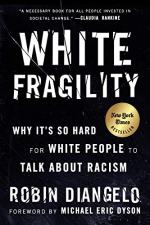
|
| Name: _________________________ | Period: ___________________ |
This test consists of 15 multiple choice questions and 5 short answer questions.
Multiple Choice Questions
1. What professional fields do white people dominate in Western society?
(a) Music industry.
(b) Film industry.
(c) Virtually all traditional professional fields.
(d) Medical world.
2. What does the birdcage metaphor describe?
(a) The forces of good and evil in society.
(b) How black people and white people interact.
(c) The interlocking forces of oppression.
(d) How humans and animals interact.
3. What does Diangelo not have to deal with in the workplace?
(a) Sexism.
(b) Racism.
(c) Classism.
(d) Homophobia.
4. With what common phrase do white people claim to value diversity?
(a) "I listen to all kinds of music."
(b) "I love all races."
(c) "I know people of color."
(d) "I don't see color."
5. What triggers white fragility, according to Diangelo?
(a) Loneliness and depression.
(b) Anxiety and discomfort.
(c) Lack of exercise.
(d) Lack of sleep.
6. What does the suggestion that being white has meaning tend to impact white people?
(a) It triggers a range of defensive responses.
(b) It makes them humble.
(c) It makes them sad.
(d) They tend to agree with the idea.
7. What happens to whites who are against racism?
(a) They still benefit from a system that privileges whites.
(b) They have more friends of color.
(c) They go to historically black colleges.
(d) Their white privileges are revoked.
8. What does Diangelo think about treating everyone the same, regardless of race?
(a) She says only certain people can be taught to treat everyone the same.
(b) She says it is impossible to teach someone to treat everyone the same.
(c) She says it is possible to teach someone to treat everyone the same.
(d) She says only people of color can treat everyone the same.
9. Who does race have a hand in shaping?
(a) Race does not shape people.
(b) People of color only.
(c) Everyone.
(d) White people only.
10. What was the name of Martin Luther King Jr.'s famous speech?
(a) I Had a Nightmare.
(b) I Had a Dream.
(c) I Was Thinking Last Night.
(d) I Have an Idea.
11. Who mistinterpreted some of Martin Luther King Jr.'s speech, as stated in Chapter 3?
(a) Asian people.
(b) White people.
(c) Black people.
(d) Immigrants.
12. What does Diangelo not have to think about as a white person?
(a) Getting pulled over by cops.
(b) Belonging.
(c) How she looks.
(d) Getting a job.
13. Why is it problematic to deny a person of color's race, as Diangelo writes in Chapter 3?
(a) Because a person of color might want to be seen.
(b) It is not problematic.
(c) Because it means being complicit in the fight against racism.
(d) Because it is not polite.
14. Why can white people not be trusted when it comes to perceptions of race and crime, according to Diangelo?
(a) White people are untrustworthy.
(b) All white people are racist.
(c) White people do not know much about statistics regarding race and crime.
(d) White people perceive danger simply by the presence of people of color.
15. What does racism need to be distinguished from in order to understand it, according to Diangelo?
(a) Love and hate.
(b) Prejudice and discrimination.
(c) Good and evil.
(d) Assumptions and bias.
Short Answer Questions
1. What does Diangelo state is always present in a relationship between a white person and a person of color?
2. According to Diangelo, what does it mean to deny a person of color's race?
3. What is a common white response to race issues in the name of color blindness, as stated in Chapter 3?
4. Who does Diangelo write has prejudice?
5. Who is Robin Diangelo?
|
This section contains 624 words (approx. 3 pages at 300 words per page) |

|




